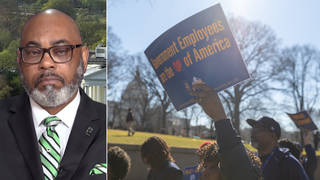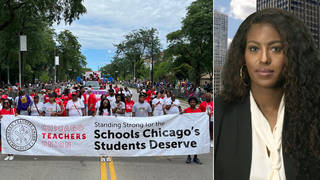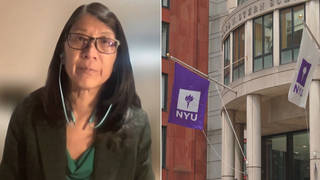
Guests
- Flint Taylora lawyer for the family of Marcus Smith, as well as a founding partner of the People’s Law Office in Chicago.
- Joseph Neffinvestigative reporter for The Marshall Project.
Despite decades of warnings against the practice, police departments across the country continue to hogtie people during arrests, sometimes with fatal results. On September 8, 2018, Marcus Smith, a 38-year-old homeless Black man in Greensboro, North Carolina, was facing a mental health crisis and asked police officers for help. Instead, eight white officers brutally and fatally hogtied him. Police videos show officers pushed Smith face down on the street and tied a belt around his ankles, then attached it to his cuffed hands so tightly that his knees were lifted off the pavement. Smith’s family filed a lawsuit in 2019 alleging wrongful death, accusing the police department of a cover-up. “The Greensboro Police Department, spearheaded by the chief of police at that time, watched the video and then chose to put out a press release that … ignored and left out the crucial factor that he was hogtied,” says Flint Taylor, one of the lawyers for the Smith family and a founding partner of the People’s Law Office in Chicago. We also speak with Marshall Project reporter Joseph Neff, who says there is little data about instances of police hogtying. “It’s hard to know how extensive it is, because there’s no reporting requirement,” he says.
Transcript
AMY GOODMAN: This is Democracy Now!, democracynow.org, The Quarantine Report. I’m Amy Goodman, with Juan González.
A warning to our listeners and viewers: This next story contains graphic police violence.
We look now at the shocking cover-up of the police killing of Marcus Smith in North Carolina. It was September 8th, 2018, when Smith, a 38-year-old homeless Black man, facing a mental health crisis, asked Greensboro police officers for help. He approached them and asked them to help him. Instead, they brutally and fatally hogtied him. Police body-camera and dashboard-camera video footage shows officers pushing Smith face down into the street and tying a belt around his ankles, then attaching it to his cuffed hands so tightly his knees were lifted off the pavement. This is part of the video footage.
POLICE OFFICER: What’s your name, partner? What’s your name?
MARCUS SMITH: My daddy call —
POLICE OFFICER: What is it?
MARCUS SMITH: I’m Marcus.
POLICE OFFICER: I know.
MARCUS SMITH: My name, Marcus.
POLICE OFFICER: OK.
MARCUS SMITH: Please, sir.
POLICE OFFICER: All right. Just stay here.
MARCUS SMITH: Please. No, sir.
POLICE OFFICER: Just go ahead and sit. Go ahead and grab a seat.
MARCUS SMITH: Man, just help me, man.
POLICE OFFICER: Just grab a seat. Grab a seat.
MARCUS SMITH: Call the ambulance.
POLICE OFFICER: Just grab a seat.
MARCUS SMITH: Call the ambulance, bro. …
POLICE OFFICER: Just take it easy.
POLICE OFFICER: We’re not going to hurt you.
POLICE OFFICER: Take it easy.
POLICE OFFICER: We’re not trying to hurt you. We’re not trying to hurt you. Settle down, bud. Come on. Roll over on your stomach.
MARCUS SMITH: [screaming]
POLICE OFFICER: Roll him the other way, towards you guys. There you go.
POLICE OFFICER: I can’t get my hand under him.
MARCUS SMITH: Help!
POLICE OFFICER: You got the cuffs?
POLICE OFFICER: Well, I did. They’re right here.
POLICE OFFICER: Now, watch your — watch your —
POLICE OFFICER: Take it easy. Take it easy. Take it easy.
POLICE OFFICER: Just watch yourself, because somebody got blood on him.
POLICE OFFICER: Take it easy.
POLICE OFFICER: Come on, bro.
POLICE OFFICER: Give us your other hand behind your —
POLICE OFFICER: Put your other hand behind you.
POLICE OFFICER: Behind your back. We’re not trying to hurt you.
POLICE OFFICER: Put your hand behind you. Hey, put your hand behind you.
POLICE OFFICER: Relax. Relax. Relax. Just relax. We’re trying to help.
POLICE OFFICER: Come on, buddy.
MARCUS SMITH: [screaming and gasping]
POLICE OFFICER: Come on, man. There we go. He’s a character. Come on, bud.
POLICE OFFICER: Is his hand going to get out of the — is there blood?
POLICE OFFICER: I don’t think so.
POLICE OFFICER: Yeah, he’s bleeding somewhere.
POLICE OFFICER: Let’s just go ahead and do this. And if you guys could help me carry him to the truck?
POLICE OFFICER: Yeah.
AMY GOODMAN: Marcus Smith’s family is charging cover-up and filed a lawsuit in 2019 alleging wrongful death.
For more, we’re joined by two guests. In Durham, North Carolina, Joseph Neff is with us. He’s an investigative reporter for The Marshall Project who examines the deaths of Marcus Smith and others across the country in a new report headlined “'He Died Like an Animal': Some Police Departments Hogtie People Despite Knowing the Risks.” And in Chicago, Flint Taylor is with us, one of the lawyers for the Marcus Smith family, founding partner of the People’s Law Office in Chicago.
We welcome you both to Democracy Now! Flint Taylor, start off by continuing to describe that night, where Marcus approached eight white police officers and asked them for help. Within minutes, he would be dead.
FLINT TAYLOR: Thank you, Amy. It’s great to be on with you and Juan and also to follow Professor Hinton.
I can’t see the video as you showed it, but just listening to it, as I have watched it several times, of course, it makes me completely upset. I’m sure that it’s tremendously traumatizing to not only people who are watching, but to the family.
What happened in that case was that these eight white police officers decided that they were going to hogtie Marcus Smith. And this wasn’t something that was unusual in the Greensboro Police Department. We have, in our lawsuit, documented that in the past five years, before the hogtying of Marcus Smith that caused his death, 275 people were hogtied by the Greensboro Police Department and that 68 or 69% of those people were African American, and over 15% of them were suffering a mental crisis, such as what Marcus was suffering.
But what happened in the case, after Marcus died in the hospital — or, actually, lost his breath and stopped breathing, and his heart stopped on the street there — the Greensboro Police Department, spearheaded by the chief of police at that time, watched the video and then chose to put out a press release that, like the first press release up in Minneapolis, ignored and left out the crucial factor that he was hogtied — what they called, in the parlance of the police department, maximum restraint. So they put out a press release that made it sound like Marcus had collapsed: He was suicidal, and he was agitated, and he just collapsed in police custody.
And that was the start of a cover-up that has continued in various forms, has been perpetrated and continues to be perpetrated not only by the police department, but by all of the politicians — many of the politicians — the mayor, the City Council, the city attorney and others in Greensboro. And, of course, as you mentioned, we have had a civil suit that we’ve been dealing with for the past two years. We have taken statements and depositions of all the main actors in the case, all the police, the chief of police, the mayor, the city manager. And what’s happening now is that the city wants to put all of that testimony and all of our arguments about why it should not be secret under seal, and they want to hold us in contempt for what they say is disseminating information, information that’s not confidential, information that should be in the public domain. They want to hold us in contempt, and, unbelievably, they want to bar us from practicing law in the state of North Carolina.
And so, that’s where we stand now in this remarkable case, a case that should be looked at along with the George Floyd case and so many other cases where unnecessary and brutal restraint is used. And it’s starting to come to light, thanks to people like Joe Neff at The Marshall Project and you, Amy, so that people can see and understand the breadth of racist police violence in this country.
JUAN GONZÁLEZ: And, Joseph Neff, I’d like to ask you. Your investigation uncovered at least 23 deaths that have occurred in the past decade from people being hogtied by police departments across the country. Could you talk about how extensive this practice is?
JOSEPH NEFF: Well, it’s hard to know how extensive it is, because there’s no reporting requirement. For example, in Greensboro, where Marcus Smith died, police do not view the hogtie as a use of force, so they don’t even count it within their own department. We made public records requests from the country’s 30 biggest police departments on use of force, every type of use of force, and we got records back from about 11 of them. So, it’s really hard for the public to know. To find these 23 people who died while being hogtied, we looked in court records. We looked for news stories. That was the — we just had to scrape the web like that to find these cases.
JUAN GONZÁLEZ: And could you talk about how many departments permit this, or which ones don’t?
JOSEPH NEFF: Well, out of the top 30 departments that we surveyed, the 30 largest, 22 of them explicitly forbid this practice. Another four — Charlotte, Houston, Indianapolis and one other — allow it under different circumstances. So, it’s hard to — I would say that the practice is more common in smaller police departments. The big ones — New York has banned this practice for decades.
AMY GOODMAN: I wanted to turn to another case. In 2017, Vanessa Peoples was doing laundry in the basement of her Aurora, Colorado, home when police officers showed up for a child welfare check. Peoples told NBC, who you did this project with, Joe, what happened next.
VANESSA PEOPLES: The next thing I knew, they threw me down on the ground, and they had my arm behind my back. And I kept telling them, I said, “There’s something wrong. My arm doesn’t feel right. It hurts.” And he had his knee in my back. And it was like, at that moment, I felt like I was going to lose my life.
AMY GOODMAN: I mean, this is Vanessa Peoples describing this, Joe. And this is Aurora. That’s where Elijah McClain would be killed a few years later, and then another woman describing the same thing happening to her. She was hogtied in front of her neighbors. And can you also talk about the hobble?
JOSEPH NEFF: The hobble is the actual strap that police use to wrap around someone’s ankles, and then they attach it either to the handcuffs or to, in the case of Vanessa Peoples, to a belt around her waist. If you showed this picture to any person in a Walmart parking lot, they would look at it and say, “Oh, that’s a hogtie,” because the feet are pulled up behind the person’s back, and the person is handcuffed behind their back. So, there’s a slight difference in that the hobble is used without attaching to the handcuffs sometimes. But it’s still — if you look at it, it’s virtually the same position.
And Vanessa Peoples, she shouted out seven times during while she was restrained, while they were restraining her, that she couldn’t breathe. And then, you’re right, they took her out, and eventually she was laying in her front yard for all her neighbors to see like that.
JUAN GONZÁLEZ: And, Flint Taylor, I wanted to ask you. You mentioned the efforts of the officials to get you — to run you out of North Carolina. But in terms of the — what kind of attacks has the Smith family had to deal with since they sought to find justice for Marcus?
FLINT TAYLOR: Well, Juan, I first want to commend the wonderful strength that Mary Smith, the mother of Marcus Smith, and the father and the sister, Kim and George, have shown, from the moment that they saw the video that revealed that their son had been hogtied. It wasn’t 'til a month later that the video was shown to the Smith family. Mary couldn't watch it, but George watched it. And that’s the first time that anyone knew, outside of the police department and the powers that be, that there was a hogtie. They had completely covered up not only the fact that he was hogtied, but the video itself. They hadn’t released it. They hadn’t moved to release it to the public.
From that moment that the family learned what actually happened to Marcus to this present day, Mary Smith, particularly, and the family, generally, has stood behind justice for Marcus Smith. And I want to say that there’s a remarkable movement on the ground in Greensboro, that is a multiracial, a multigenerational movement, that appears at every City Council meeting and asks questions about what in fact is being done about this case. They stand in front of City Hall every Monday — Mondays for Marcus — with banners calling for justice in the Marcus Smith case. And one of the things that the — what’s being demanded by the movement on the ground there is that there be a full apology from the mayor and the City Council for the death of Marcus Smith, there be a memorial for Marcus Smith in the city of Greensboro, and there be just compensation for the family.
The City Council and the mayor have been doing a lot of different diversionary tactics, a lot of misinformation publicly, including slandering the family, and particularly Mary Smith, who is the plaintiff in our lawsuit. We’ve been trying to fight back publicly. And that’s when they came down on us and said, “We can talk, but you can’t.” And I think that it raises — not only does the hogtying and the idea of the different kinds of prone restraints that are used across this country that being so dangerous because of positional asphyxia and sudden death syndrome and all those kinds of activities, but also now we’re looking at an attack on lawyers, an attack on the community, which they are singling out, as well as the community activists who have spoken up — a First Amendment attack.
AMY GOODMAN: Flint, you mentioned Kim Smith, Marcus’s sister. This is Kim speaking to NBC about the treatment of her brother.
KIM SUBER: Imagine your closest sibling, looking at them die. … I had no idea what a hogtie was. I had no clue. That’s how you treat an animal.
AMY GOODMAN: So, looking at this nationally, the scores of people who have died with this use of the hobble, no centralized database about how it is used, Joe Neff, the responses of the police departments to your repeated requests to explain what their policies are?
JOSEPH NEFF: Some departments were very helpful. And actually, in Aurora, they released the data. They actually released on the types of restraints that they were using. So, that is how we were able — is one of the few cities where we could actually count the times the hobble was used. And to their credit, in the —
AMY GOODMAN: We have 15 seconds.
JOSEPH NEFF: OK. Their credit, the police chief has denounced the practice and fired the officer who hobbled Shataeah Kelly and left her in the well of a car for a drive down to the police station. She has denounced it.
AMY GOODMAN: An astounding story, which you write about in your Marshall Project piece, “'He Died Like an Animal': Some Police Departments Hogtie People Despite Knowing the Risks.” We will link to it. Joe Neff, thanks so much for being with us, and also Flint Taylor, lawyer for Marcus Smith’s family, with the People’s Law Office in Chicago. This is Democracy Now! I’m Amy Goodman, with Juan González. Stay safe. Wear a mask.












Media Options